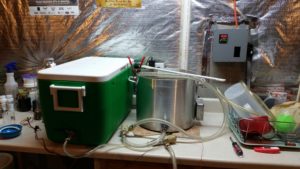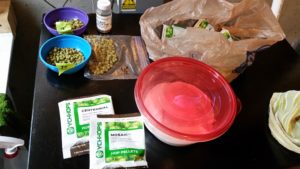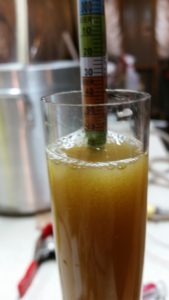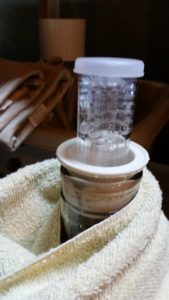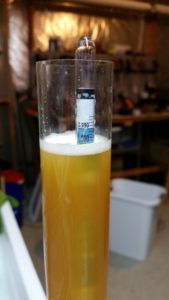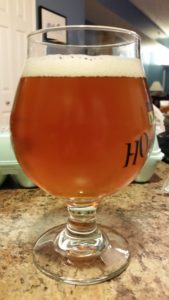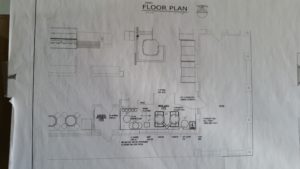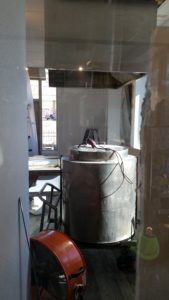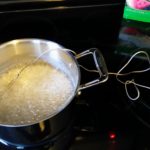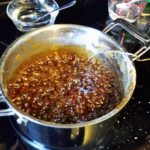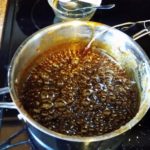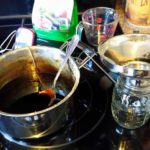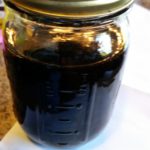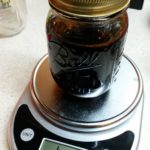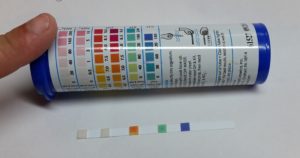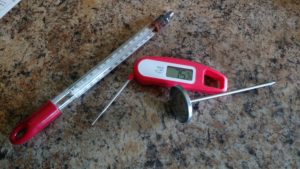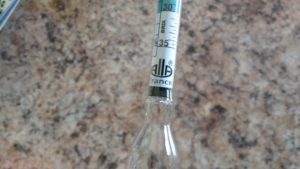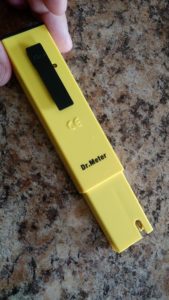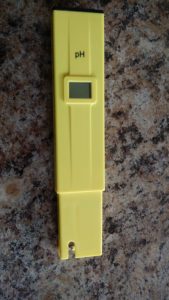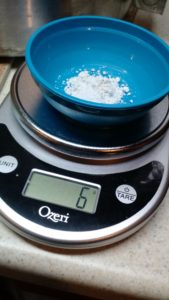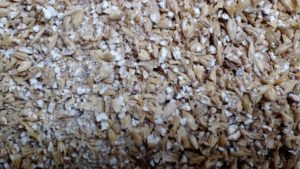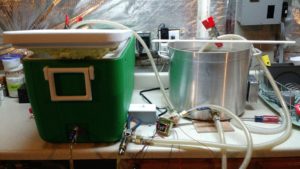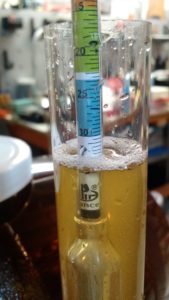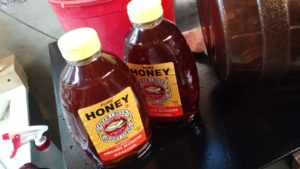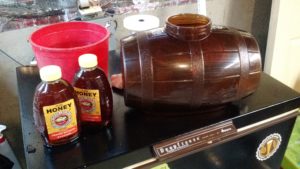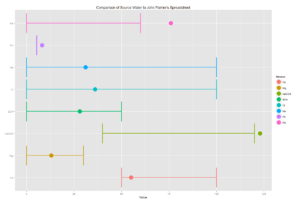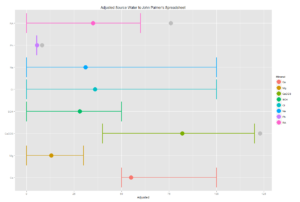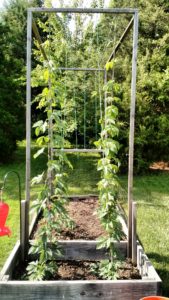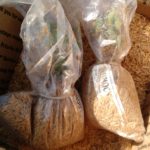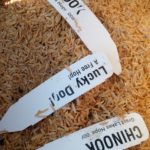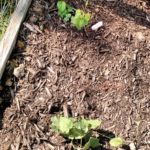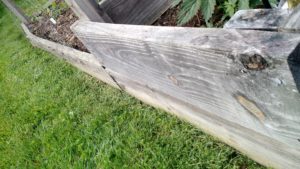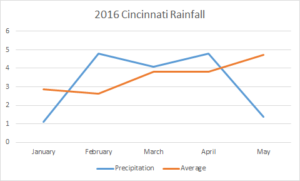Author Archive: Andrew
Merry Christmas!
I’m sitting here one chapter into my gift…
If you haven’t listened to the podcasts about the book, they are worth a listen (Basic Brewing Radio May 19, 2016 episode, BeerSmith). The basic premise of the book is to interview some all-stars to try and spread their knowledge. Since it would be a mess otherwise, the all-stars are broken out into four archetypes: Recipe (and Ingredient) Innovator, The Scientist (and Process Nerd), The Old School Master, and The Wild One.
I took the test. Like many others, I fall into multiple groups, but mostly the Scientist and Process Nerd. Old School Master, Innovator, and Wild are the other three places, with the scores from Scientist, Old School, and Innovator being fairly close.
Also for Christmas I got a pH meter. Shocking after seeing my architype.
Cheers and Merry Christmas!
Imperial Hoptrooper Brew Day and Tasting Notes
On November 20, I brewed my biggest (and most successful in terms of numbers) beer – a double IPA. Recipe inspiration came from MadTree’s High series, which is a series of IIPAs that are quite popular and very well rated (note: there are three “highs” that I know of, the Galaxy and Citra, which are linked in the text, and Azacca which is not… but it’s also f**king tasty! There may have also been a Mosaic High).
The recipes are similar. I did a fair bit of ‘back of the napkin’ analysis on the two beers, looking at the percentages of grain, the AAU at each addition, etc. I ended up with the recipe below.
Recipe Details
| Batch Size | Boil Time | IBU | SRM | Est. OG | Est. FG | ABV |
|---|---|---|---|---|---|---|
| 5.5 gal | 60 min | 123.7 IBUs | 5.9 SRM | 1.074 | 1.014 | 7.8 % |
Style Details
| Name | Cat. | OG Range | FG Range | IBU | SRM | Carb | ABV |
|---|---|---|---|---|---|---|---|
| Double IPA | 22 A | 1.065 - 1.085 | 1.008 - 1.018 | 60 - 120 | 6 - 14 | 2.4 - 2.9 | 7.5 - 10 % |
Fermentables
| Name | Amount | % |
|---|---|---|
| Pilsner (Hoepfner) | 10.5 lbs | 72.41 |
| Vienna Malt (Briess) | 2.25 lbs | 15.52 |
| Caramel/Crystal Malt - 40L | 8 oz | 3.45 |
| Carapils (Briess) | 4 oz | 1.72 |
| Corn Sugar (Dextrose) | 1 lbs | 6.9 |
Hops
| Name | Amount | Time | Use | Form | Alpha % |
|---|---|---|---|---|---|
| El Dorado | 1 oz | 60 min | Boil | Pellet | 15 |
| Galena | 1 oz | 60 min | Boil | Pellet | 12.5 |
| Centennial | 0.5 oz | 30 min | Boil | Pellet | 10 |
| Mosaic (HBC 369) | 0.5 oz | 30 min | Boil | Pellet | 12.3 |
| Centennial | 0.5 oz | 15 min | Boil | Pellet | 10 |
| Mosaic (HBC 369) | 0.5 oz | 15 min | Boil | Pellet | 12.3 |
| Centennial | 1 oz | 15 min | Aroma | Pellet | 10 |
| Mosaic (HBC 369) | 1 oz | 15 min | Aroma | Pellet | 12.3 |
| Centennial | 2 oz | 0 min | Dry Hop | Pellet | 10 |
| Mosaic (HBC 369) | 2 oz | 0 min | Dry Hop | Pellet | 12.3 |
| Chinook | 1.5 oz | 0 min | Dry Hop | Pellet | 13 |
| Citra | 1 oz | 0 min | Dry Hop | Pellet | 12 |
Mash
| Step | Temperature | Time |
|---|---|---|
| Mash In | 152°F | 60 min |
Download
| Download this recipe's BeerXML file |
I kept closer to the size of the Citra High recipe, mostly because I am still working through efficiency issues (it’s getting better, though). I still didn’t get MadTree’s efficiency, but to be fair, I’m targeting 75%, not 82%!
Brew Day
I’m happy to say that the only issues during brew day was how long it took and higher than expected grain absorption. I started later in the day (around 2:30 PM) and it didn’t end until maybe 6:30PM. There were no stuck sparges, clogged lines or chillers, boil boiled. I ended up with about 4.5 gallons into the fermenter, which is less than the 5.5 gallons I was targeting. However, the lower volume works better with my 7.5 – 8 gallon kettle.
Throughout fermentation, the temperature (as measured on the side of the fermenter) stayed at 68, which is a nice perfect temperature.
Tasting Notes
Aroma: Grapefruit mostly
Appearance: Copper, opaque. White head that starts thick and persists as a thin head.
Taste: Tongue lashing bitterness with citrus tones. Some alcohol flavor.
Mouthfeel: Moderately carbonated, slight citrusy tartness lingers past the dry finish.
Overall Impression: I’m biased, but I love this beer. I’ve been drinking the heck out of this!
OG: 1.071
SG: 1.005
ABV: 8.7%
IBU: 124
SRM: 6
What’s Next With This Recipe?
I want to try two things – one is maybe a little less bitterness. The other is honey instead of sugar. I’m wondering if some Orange Blossom honey would work well with the citrus based hops.
Cheers!
Totally “Unauthorized” Look at a New Cincinnati Brewery
Unauthorized? Yeah maybe. This is in plain sight, so it’s fair game, right? I’m not a journalist anyway…
There is another new “brewery” coming to Cincinnati, Mio’s Pizza in Anderson (at the corner of Eight Mile and Clough Pike).
I go to this Mio’s somewhat regularly (the pizza is great, and the beer list is excellent), and I also go to Paradise Brewing regularly (because homebrewing!). I initially heard about Mio’s plans at Paradise, and saw them coming to fruition over the last few visits.
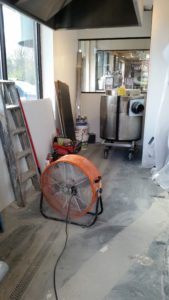
That same HLT (I think). Looks like a fermenter was in the bar and I didn’t notice… I guess I’ll have to go back for more recon. (pic: 11/20/16)
Based on the plan, it looks like one 2 bbl fermenter, so obviously not a huge production so it seems highly likely they will still maintain their excellent selection of craft beers*. One of the things talked about with some of the newer craft breweries is a return to having neighborhood breweries. This seems to fall in line with that, but with brewing being second to food. Given the small scale of production, that’s probably going to be fine.
I haven’t talked to the owners or anything, but since they are growing hops outside and they have good pizza and service, I’ll definitely give their beers a try, and I’ll be monitoring their progress… as I drop by to have a pizza with the family.
Update: This was supposed to post on November 21, but it did not. A few weeks (or less) after writing, I stopped in and was told by a waiter that their brewery will be more educational/community, which will be pretty cool!
Cheers!
‘* = the beers I can remember include MadTree Pilgrim, Nowhere In Particular Batch 4, Stone Enjoy By 7/25/16 Tangerine IPA, Figleaf Iso-Trope, Old Firehouse The Chief, Jackie O’s Firefly Amber, Urban Artifact Kicksled.
Made Dark Candi Syrup
I’ve been thinking about my next homebrew being a Belgian Strong Dark Beer. In the research process, I found two Chop & Brew Episodes, and both use dark candi syrup. Since I’m tight (a little) and since it’s basically sugar, I decided to make my own.
Off to the interwebs, I found a post by Mad Fermentationist that mentioned a Ryan Brews post in the comments. Looking at the Ryan Brews page, I used pickling lime and DAP (yeast nutrient, I used LD Carlson, which I had on hand).
I only scaled the recipe up, so I used:
1 pound sugar
1/2 cup water
1 tsp pickling lime
1 tsp yeast nutrient
I brought it to a boil and held it to around 280º – 300ºF for 40 minutes. After that, I removed it from the heat, let it cool for a few, and added 1/3 cup of water and stirred it in to make it a syrup.
The two things I will do differently next time:
- Dissolve the lime and dap in the water before adding it to the sugar. I had a lot of large flakes that I think (operative word!) are from the lime.
- Use a better thermometer setup. My grill thermometer was reading 280º for a while including in boiling water, so I hope the thermocouple isn’t ruined. I’m letting it dry and will test it later. Edit a few days later: the thermocouple is saying 129º while sitting next to the food thermocouple reading 73º. I’ve ordered a replacement!
Cleanup of this stuff isn’t too difficult, the best way is to boil everything, even if you don’t make it to a boil, very hot water can dissolve the sugar/caramel.
- Starting…
- After 25 minutes of boil…
- After ~37 minutes of boil…
- End of boil, diluted, and ready to be packaged.
- In the jar, ready to be used.
- Just over a pound of syrup.
Water Part Deux
So after the low mash efficiency last few beers AND my perception (note 1) of low mash efficiency in my last beer, I started looking at water more.
After looking at my options, I found a page on Braukaiser, and ended up purchasing an aquarium test kit that tests GH, KH, pH, NO2, and NO3. The NO2 and NO3 are unnecessary for brewing, and I had 0 ppm for both of those anyway. Using the spreadsheet and my 180ppm measurements for both GH and KH, I found Ca = 51 ppm and Mg = 13 ppm.
That’s not too different from my old measurements:
Ca: old 54, new 51
Mg: old 13, new 13
The two interesting differences are alkalinity and pH.
Alkalinity: old 123, new 180
pH: Old 8.1, new 7.5.
The total alkalinity is a concern – that’s the ability of the water to buffer changes in acidity. And my pH is lower than expected. So I may not have had the wort in the proper pH range. This could be why I’ve had efficiency problems.
That being typed, I need a good pH meter. That’s really the only point that I came to after all this.
Note 1: I initially thought that I had really poor efficiency, and there is a problem somewhere in my measurements… particularly not taking a pre-boil gravity. I have the first running and the second running and the OG, and I determined a potential amount of sugar in the two runnings and it may be okay. The real problem was that I had far too much strike water and didn’t make any adjustments. I DID figure out that if I use Denny Conn’s method, I can safely assume his assumption that 10 pounds of grain absorbs 1 gallon of strike water, because mine is a hair over that.
On to the next beer!
Homebrew Ramblings 1
When I started writing this, I was sitting and waiting on the mash. This was my first brew since my attempt at the Redneck RIMS.
I’m not trying that again. I don’t think it was smart to cobble together some stuff and do something that just made things more difficult. I’ve been reading a lot, and a few posts on the Beer Simple Blog kinda got me to change from trying to make RIMS happen to just concentrate on making beer.
Last Sunday’s beer was inspired by Great Lakes’ Nosferatu. It’s an awesome beer. I don’t brew clone beers, but I DO use clone recipes as starting points. I changed the base malt to Maris Otter, and I’m using all Chinook hops. I’m using Northwest Ale yeast, too. When I initially typed this, I was in the mash and temps were looking good (154 – 155). Unfortunately, there were other problems, but in the end, I have about 4.5 gallons of beer and I learned a few things for the next time.
Specifically:
- Dried hope cones go into a bag, because despite what I’ve read in someone else’s brewing book, they don’t create a “filter bed”, they get stuck in pumps and plate chillers.
- Better Bottles can’t handle 200ºF wort. They tell us this, and we’d do well to remember.
- Expect that pumps change how much water your grain “absorbs”.
- Speaking of pumps, standardizing all fittings to one singular fitting (i.e. cam locks or tri-clamps) is probably a good thing to do.
- Disasters will happen. Even homebrewing should have a disaster recovery plan (backup pumping system, a backup method to chill wort isn’t bad either, backup measurement devices, etc.).
Cheers!
Homebrew Tool Calibration
I have issues. Efficiency issues. The first step to fixing a problem is admitting you have a problem. The second step is finding out who/where to blame the problem on!
This is the first in a series, although I do not know how long the series will be (until I fix the problem).
The most likely problem based on the sheer number of times I’ve done Internet research on this problem and had conversations with other homebrewers is the crush. I’ve never wanted to accept this as the problem because my LHBS uses the same mill (that may have changed now that they’ve moved to being an actual brewery and don’t want to spend two hours milling grain). However, I did my due diligence and accused asked them…
we sit right about 74-75%
— Paradise Brewing (@paradisebrews) August 12, 2016
The Twitter conversation goes on longer, but the end result is to check everything. So I did…
Temperature Probes
I compared the three at two temperatures and two of them (the dial and the Javelin that I normally use) at a third. In ice water, the floating thermometer and the dial agreed at 34ºF while the Javelin read 35ºF when the battery was kept out of the ice water (while it is waterproof, I think it is better to keep the battery out of the water). In tap temperature water, they all read 73ºF. In near-boiling water (with the stove turned off), the dial said 194ºF and the Javelin said 195ºF (I didn’t try the floating thermometer). I feel fairly confident that the Javelin, which I use the most, is close enough.
Hydrometer
My tap water (not distilled!) is at 0.999 SG after correcting for temperature, so we’ll go with 1.000. That’s a single-point calibration, which assumes that the hydrometer correctly measures throughout it’s range… which is a lofty assumption.
The second point was 15g sugar + 150g water, which by calculation should be 9.1º Plato, I got 10.2º Plato. HOWEVER, my scale is only accurate to 1g, so the range is 14.5g – 15.4g sugar + 149.5g – 150.4g water. This means that the calculated error could be anywhere from 8.8º Plato to 9.3º Plato. So I’m reading about 1.1º Plato high there.
I did a third point as well. 30g sugar (29.5g – 30.4g) +150g (149.5g – 150.4g) water. Should be 16.7º Plato in the range of 16.3º Plato to 17º Plato. I got 15.8º Plato, 1.1º Plato low. 16.5º Plato is 1.068, 15.8º Plato is 1.065. While this sounds like a lot, it isn’t, and I’ve been having problems on the order of 10 points (e.g. wanting 1.052 for 75% efficiency pre-boil and getting 1.043).
All this stuff seems so screwy (I tried the third point test twice) that I’m not considering this to be a done deal. But I’m buying a few more hydrometers!
pH Meter
I admit that I haven’t been as nice to this meter as I should – I dropped it in wort and rinsed it off, and I’m pretty sure it isn’t waterproof. But this thing is currently unusable. I checked it using distilled water (pH of 7.0), my tap water (pH of 8.1) and tap water with cream of tartar dissolved in it – which creates a buffer at a pH of 3.6.
I believe this meter worked correctly once. However, it no longer does. If I calibrate it at 7.0 (distilled water), the 3.6 pH buffer solution from cream of tartar is about 4.6 – 5.7 (that’s a huge range!) and it sets my tap water around 9.2 (it’s alkaline, but it’s not THAT alkaline!).
I’m going to replace this, but for now I’m going to rely on calculations using John Palmer’s spreadsheet.
Next Steps
I’m going to reread How To Brew (just the section about mash tuns) to make sure I didn’t screw up the mash tun somehow (I probably didn’t, but you never know). I’m going to redo the hydrometer test with at least two more hydrometers that I’m going to get this week (this is one of those things that we should have extras of anyway). I’m going to replace my pH meter (I kinda implied that already). I also may get a water sample to Ward Labs to see what my water is actually like coming out of the pipe.
Cheers!
Brew Day: Vampire Dust Pale Ale and a Mead
Yesterday (at the time of writing) was Mead Day. Since I’m down to just a session wheat beer, I needed a pale ale, and I just wanted to make a mead.
Vampire Dust Pale Ale
Brewing went off with mostly few hitches except slowly hitting my strike temperature due to this redneck RIMS setup (to be documented further later).
Recipe Details
| Batch Size | Boil Time | IBU | SRM | Est. OG | Est. FG | ABV |
|---|---|---|---|---|---|---|
| 5.5 gal | 60 min | 44.9 IBUs | 5.2 SRM | 1.059 | 1.011 | 6.3 % |
| Actuals | 1.054 | 1.01 | 5.8 % | |||
Style Details
| Name | Cat. | OG Range | FG Range | IBU | SRM | Carb | ABV |
|---|---|---|---|---|---|---|---|
| American Pale Ale | 18 B | 1.045 - 1.06 | 1.01 - 1.015 | 30 - 50 | 5 - 10 | 2.3 - 3 | 4.5 - 6.2 % |
Fermentables
| Name | Amount | % |
|---|---|---|
| Brewer's Malt, 2-Row, Premium (Great Western) | 11 lbs | 90.72 |
| Carapils (Briess) | 12 oz | 6.19 |
| Caramel/Crystal Malt - 40L | 6 oz | 3.09 |
Hops
| Name | Amount | Time | Use | Form | Alpha % |
|---|---|---|---|---|---|
| Green Bullet | 0.5 oz | 60 min | Boil | Pellet | 13.5 |
| Citra | 1 oz | 15 min | Boil | Pellet | 12 |
| Citra | 1 oz | 5 min | Boil | Pellet | 12 |
| Citra | 3 oz | 7 days | Dry Hop | Pellet | 12 |
Miscs
| Name | Amount | Time | Use | Type |
|---|---|---|---|---|
| Irish Moss | 1.00 tsp | 15 min | Boil | Fining |
Yeast
| Name | Lab | Attenuation | Temperature |
|---|---|---|---|
| London Ale Yeast (1028) | Wyeast Labs | 75% | 60°F - 72°F |
Mash
| Step | Temperature | Time |
|---|---|---|
| Mash In | 148°F | 60 min |
Download
| Download this recipe's BeerXML file |
My First Mead
This is the fist time I’ve attempted mead, and I tried to keep it as simple as I can:
Ingredients: 4 lb Orange Blossom Honey, water to make 1g, yeast, LD Carlson Yeast Nutrient and LD Carlson Yeast Energizer
Yeast: Lavlin 71b, 5g
Process:
Rehydrate yeast with 125 ml water and 6.25g LD Carlson Yeast Nutrient
Add all honey to fermenter, water to 1 gallon, mix well. Pitch yeast. Forget to add first SNA (oops).
Following morning: add first two SNA’s, mostly because I don’t have a way to measure to tenths of grams.
The SNAs should be 0.4g Nutrient and 0.2g Energizer each addition, at pitch and at each of 24, 48, and 72 hours post-pitch.
Vampire Dust Pale should be ready in 10 days or so, the mead will be a while.
Cheers!
My First Sour: a Flanders Red?
I’ve been wanting to do a few sours for a while, and recently purchased two Better Bottles for the purpose of one being a sour-only fermenter. I’m merging two recipes, one is the on the Milk The Funk Wiki, which is the malt bill for The Rare Barrel beers. Since it is only part of a recipe, I took the other part from the Flanders Red Solera recipe from the Bloatarian Brewing League (a Cincinnati homebrew club) – specifically the hopping, mashing schedule, and yeast.
Water
My base water is pretty close for a Flanders Red, just a tad alkaline.
The only adjustments are basically pH, so once I add a milliliter of Lactic Acid, it puts the water right in line with where it needs to be.
Recipe
Recipe Details
| Batch Size | Boil Time | IBU | SRM | Est. OG | Est. FG | ABV |
|---|---|---|---|---|---|---|
| 5.5 gal | 60 min | 17.1 IBUs | 13.4 SRM | 1.053 | 1.012 | 5.4 % |
| Actuals | 1.046 | 1.01 | 4.7 % | |||
Style Details
| Name | Cat. | OG Range | FG Range | IBU | SRM | Carb | ABV |
|---|---|---|---|---|---|---|---|
| Flanders Red Ale | 23 B | 1.048 - 1.057 | 1.002 - 1.012 | 10 - 25 | 10 - 16 | 2 - 2.7 | 4.6 - 6.5 % |
Fermentables
| Name | Amount | % |
|---|---|---|
| Pilsner (2 Row) Bel | 8 lbs | 71.11 |
| Wheat Malt (Barrett Burston) | 1.5 lbs | 13.33 |
| Caramel/Crystal Malt - 60L | 8 oz | 4.44 |
| Oats, Flaked | 8 oz | 4.44 |
| Vienna Malt (Briess) | 8 oz | 4.44 |
| Carafa II | 4 oz | 2.22 |
Hops
| Name | Amount | Time | Use | Form | Alpha % |
|---|---|---|---|---|---|
| Mt. Hood | 1 oz | 45 min | Boil | Pellet | 6 |
Miscs
| Name | Amount | Time | Use | Type |
|---|---|---|---|---|
| Lactic Acid | 1.00 ml | 60 min | Mash | Water Agent |
| Oak Chips | 4.40 oz | 7 days | Secondary | Flavor |
Yeast
| Name | Lab | Attenuation | Temperature |
|---|---|---|---|
| Roselare Belgian Blend (3763) | Wyeast Labs | 80% | 55°F - 80°F |
Mash
| Step | Temperature | Time |
|---|---|---|
| Mash In | 156°F | 90 min |
Download
| Download this recipe's BeerXML file |
This is still in progress, and the oak is questionable at this point.
2015 Suburban Farm Report #1
The second year Cascade (front left), Centennial (rear left), Tettnang (front right), and Columbus (rear right) are coming along well. I’m a little concerned on one of the cascade bines, as it broke when I was trying to get it to train on the horizontal rope. Hopefully it can repair itself.
Hop Plant Expansion
This year I expanded to a full-ish garden. I ordered a Chinook plant from Great Lakes Hops.
- Uhhh… I thought I ordered one!
- Woo Hoo!
- New Chinook plants
Repairs and Other Stuff
My garden is raised a little, but it is not holding up. I need to replace the 2x6s I used to build it with something stronger and more able to hold up.
The rain hasn’t helped. This is as of 5/16/16, so only half of May is reported. As shown in the graph below,
I want to get some Jalapeno plants started, but I’m running late (May has been a busy month). We just had a cold snap here (as I’m typing this), so I’m okay with not getting them into the ground. But it will need to happen soon.
Cheers!

